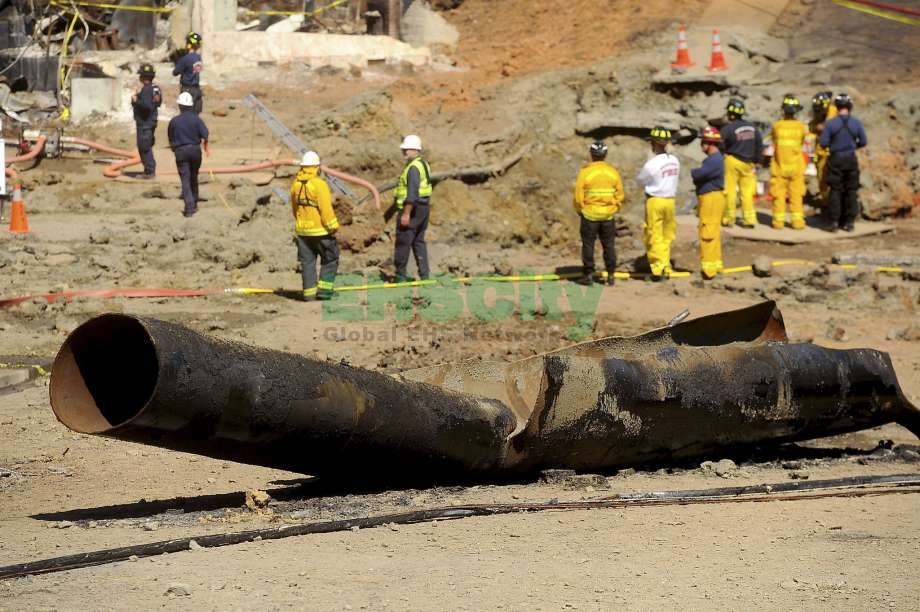
A San Bruno woman who lost her 20-year-old daughter in the deadly explosion of a Pacific Gas and Electric Co. pipeline in September 2010 urged a federal judge Monday to punish PG&E for criminal violations of safety laws and lamented that only the company and not its executives would be penalized.
“Unfortunately, not one of the CEOs will see the inside of a jail cell,” Rene Morales said in tearful testimony at PG&E’s sentencing hearing for six felony convictions. “They didn’t take public safety first.”
After hearing from witnesses and opposing lawyers, U.S. District Judge Thelton Henderson postponed a sentencing decision on PG&E until Thursday. But he said he intended to impose the maximum fine allowed by law, $3 million, and to appoint a monitor to supervise the utility’s compliance with safety rules, a condition the company has accepted.
A jury in San Francisco convicted California’s largest public utility in August of five felony charges of failing to adequately inspect and maintain its aging gas lines, and a sixth charge of obstructing the federal investigation of the September 2010 explosion and fire. No company executives were charged with crimes.
PG&E’s “criminal conduct in this case was quite serious” and, if continued, “makes such incidents more likely” in the future, Henderson said in explaining his decision to fine the company $500,000 per violation and impose the maximum period of probation, five years. He said he was also inclined to require the company, as a condition of probation, to mention its criminal convictions in future advertisements proclaiming its devotion to safety.
The explosion and fire on Sept. 9, 2010, destroyed 38 homes in San Bruno’s Crestmoor neighborhood, killing eight people and injuring 58. The cause was a defective seam weld in a PG&E pipeline, installed a half century earlier, that company charts records had described as seamless.
Jessica Morales, who was studying to be a fashion journalist, was watching a football game at her boyfriend’s home that night and was caught in the flames. Her boyfriend, Joseph Ruigomez, had stepped outside the home, then rushed back to try to save her, but was severely burned. He spent more than a month in a coma but survived.
“We were sisters at heart,” Rene Morales told the judge, wiping her eyes with a tissue. She remembered her daughter’s last words to her before leaving for Ruigomez’s home: “Don’t worry, Mom. I promise I’ll be back by 9.”
“I wish I hadn’t let her out the door,” she said.
Also testifying was Sue Bullis, who lost her husband, Greg Bullis, 50, his 17-year-old son, William, and Greg Bullis’ 82-year-old mother, Lavonne Bullis.
“My life changed forever ... due to the negligence of the greedy company,” Sue Bullis said.
“I truly did not want to live,” she said. After she sued the company, she said, its lawyers were “cruel and insensitive ... to the victims.”
Julie Kane, hired by PG&E in 2015 as its chief ethics and compliance officer, gave a brief statement at the hearing saying the company was “profoundly sorry” to the victims and their families and “will remain forever committed to taking action to meet the high safety standards that our customers, and we, demand and respect.”
While PG&E contended the explosion was unforeseeable, current and former employees testified during the six-week trial that the company had deliberately chosen the least-expensive inspection method for its lines, knowing it could not detect internal flaws.
Jurors also found that PG&E had tried to interfere with the federal investigation by covering up its practice of pumping natural gas through the lines at pressures up to 10 percent higher than those allowed by federal law.
The jury acquitted PG&E of six charges of knowingly keeping defective records of pipeline tests and repairs.
Prosecutors had initially sought a fine of up to $562 million, which they said was twice the amount PG&E had saved by cutting safety programs. But they lowered their request to $3 million, the maximum criminal penalty provided by law, after Henderson barred much of the evidence they had planned to use to prove illegal cost-cutting.
The state Public Utilities Commission has already fined PG&E a record $1.6 billion for the explosion, an amount charged to shareholders rather than to customers.
The appointment of a monitor to oversee PG&E’s compliance was initially proposed by the city of San Bruno, a day after the jury verdict, and later endorsed by federal prosecutors. Henderson said Monday that PG&E had accepted the idea, but he did not say whether the monitor would have any authority over the company’s operations, information that presumably will be revealed at Thursday’s sentencing.
The judge said he was unlikely to go along with prosecutors’ request for a PG&E advertising campaign that would focus on the criminal case. But he said he’s inclined to order, as part of the company’s sentence, that “advertising touting PG&E’s commitment to safety must include its criminal convictions, that it was found liable for knowingly and willfully violating safety” laws.

